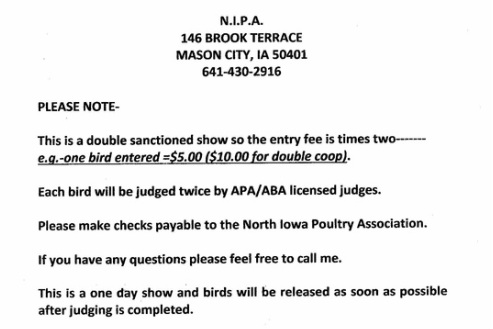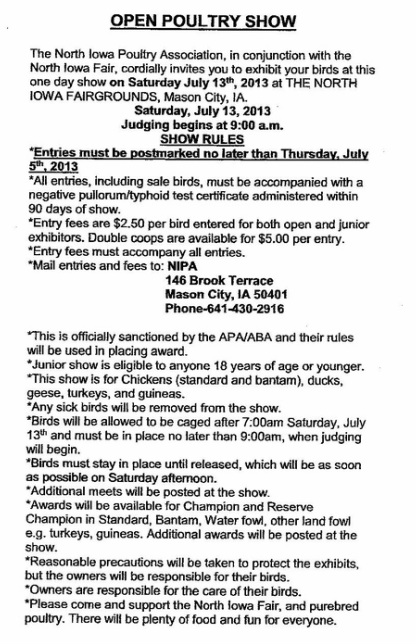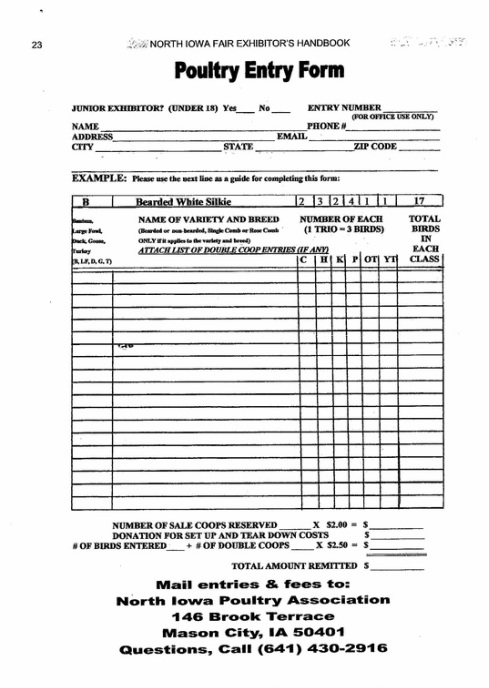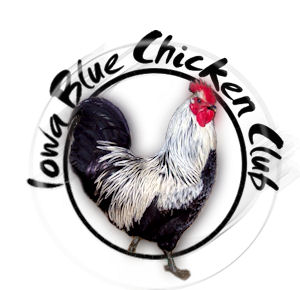July 13th IBCC Meeting – Open to entire membership
in conjunction with the NIPA Show in Mason City, IA (information below)
Main Discussion Items:
in conjunction with the NIPA Show in Mason City, IA (information below)
Main Discussion Items:
- Put a “Showing Tips” tab on the website? Place a reminder that when showing one’s Iowa Blues, make sure to enter them according to the breed AND variety. (Example Silver Penciled Iowa Blue, Birchen Iowa Blue). Also, remind buyers of this information when they go to show. We must do everything we can to educate so as to dispel confusion.
- Update Standard? Re-open Standard Committee meetings?
- Head shape on the hen is listed as medium in size.
- Curt: I would like to see the standard reflect the desired round head of the hen in its wording.
- Proposed change: Medium in size, round in shape.
- Curt: I would like to see the standard reflect the desired round head of the hen in its wording.
- Front of neck on the Silver Penciled cock. Currently “black.”
- Curt: Should contain lacing as I believe a black neck with laced breast would be genetically difficult if not impossible.
- Proposed change: Have wording the same as front of neck on Birchen cock?
- Curt: Should contain lacing as I believe a black neck with laced breast would be genetically difficult if not impossible.
- Back angle/levelness.
- I very much prefer (and remember level backs on my old stock) however a sloping back seems more prevalent today as Ideal’s line is the most common.
- Proposed change: Back: Slightly sloping, with tendency toward levelness.
- I very much prefer (and remember level backs on my old stock) however a sloping back seems more prevalent today as Ideal’s line is the most common.
- Heads on the Birchen hens.
- Should our Standard reflect a darker head on the hens? I believe we can still have a nicely laced breast and hackle while at the same time making allowances for a darker head on the hen.
- Proposed change: Forehead black, frosting permissible, slowly transitioning to a heavy silvery white lacing at hackles and.
- Should our Standard reflect a darker head on the hens? I believe we can still have a nicely laced breast and hackle while at the same time making allowances for a darker head on the hen.
- Head shape on the hen is listed as medium in size.
- Discuss the formal process of APA SOP admittance. Decide which shows will be attended through the admittance process as well as where we’d like to have the qualifying meet. Suggestions for “local” meets would be the Avoca Show and the Eastern Iowa Poultry Show. Any shows located in NE Iowa that would be of interest? Qualifying meet at EIPA?
Updates/New Information
- Don Hellner and his Birchen line of Iowa Blues. Any takers on trading eggs with him?
- Update on Backyard Poultry Breed Focus.
- Update on SPPA Breed Brochure.
- Update on Feathersite updating their Iowa Blue link.
- Gauge potential interest in getting the Iowa Blue admitted into the Slow Food’s USA – Ark of Taste and what is involved in getting them admitted.
- 2014 Breed Club Booth at the EIPA?
- Have maybe 2 pairs SP, one pair of Birchen Iowa Blues to auction off at the show. Proceeds going to the club.
- Have print outs of our Standard (on cardstock?) to give out to those individuals who are interested.
- Have print outs about breed History and Characteristics to make available to interested parties.
- Club logo stickers of both the cock and hen to give to the children.
- Designate individuals to head up a “Booth Committee” to set the details, time, volunteer to man the booth, etc.
- Have maybe 2 pairs SP, one pair of Birchen Iowa Blues to auction off at the show. Proceeds going to the club.
- Curtis has lady named Barb Day (who works in the Genealogy department of the Decorah Library) currently investigating for any Iowa Blue information. Areas that she is diving into include searching the local papers from 1920-present, contacting the Decorah Historical Society, and connecting to Decorah residents who are interested in Decorah history via Facebook. Hopefully she’ll turn something up!
- Breed Promotion. See Iowa Blue Breed Promotion document listed below.
- Coralville Iowa Blue Hen Sculpture.
- Connie is in communications with a NY Artist Virginia Carabelli regarding her Portrait and Exhibition of the Iowa Blue artwork (along with 10 other rare breeds). She has requested feathers and blown out eggs for display to the public along with her art exhibition. She welcomes pamplets and other promotion materials from the IBCC, if we wish to send them to her. After discussion, it sounds like she is going to paint both the cock and the hen (instead of rooster only) for the Iowa Blue portrait, given how distinctive the girls are and how important their appearance is in this breed.
Iowa Blue Breed Promotion
A lot of times what we see with new/rare breeds is some sort of catalyst that sparks a strong public desire to raise/breed/possess a said breed. If the breed is new, people will be drawn to its uniqueness and limited availability. If the breed is old, but rare, most people will be drawn to its rarity and desire to raise it because of how limited the stock is. An interesting note about rare breeds in particular is that the breed may flounder and flirt with extinction for decades and only when someone becomes involved with the breed do others then begin to feel drawn to the breed themselves. These breeds (whether new or rare) experience a period of upward momentum only to be faced with staggering support or near extinction (sometimes yet again) in but a few short years once the “newness” has worn off and the “market” flooded.
We are at the start of our upward momentum for the Iowa Blue, and I believe that if we make some smart and innovative choices now, we have an opportunity to extend our breed’s growth without experiencing the “death dive” that so many breeds experience. Most breed clubs, who were at the stage we are currently in, focused all their energy on the Standard and SOP admittance without a thought as to the future beyond the SOP. How many times do we see a breed finally pass the qualifying meet only to be tossed aside, nearly extinct, inbred, and desperate for vigorous stock but 5-10 years later? The club stopped their focus once the main goal was met (as they felt their “work” was finally completed), and the breed declined without the drive and focus of the club. So, in light of this, here are a few ideas of areas I feel we should focus;
- Stock Quality- This is an obvious focus area and one that is usually achieved via an aggressive selection for the standard. But, here’s where we can set ourselves apart from other breed clubs;
- Aggressively encourage and educate breeders (both new and old) to select hard in their breeding pens
- Embrace breed diversity via breed varieties and most importantly the establishment of new lines. The establishment of new lines is of the utmost importance to breed vitality and vigor, and should be (in my opinion) THE main focal point, at least for the near future.
- Education- This is where most if not all breed clubs really fall short. There is much to educate our breeders and membership on when it comes to the Iowa Blue. Per a recent meeting with Glen Drowns, the Iowa Blue has experienced not only extreme near extinction multiple times, but two distinct controversies have resulted in excessive misunderstanding of the breed. Our education focus should be a three pronged approach;
- Dispel Misconceptions. We need to “call out” the misconceptions and provide the historical evidence to back up the truth needed to eliminate the confusion caused by the misconceptions. We’ve already come along ways with our breed Historical Archive, but we can do more, (for example, hand out fliers at shows which cover the high level breed history facts). The key is to reach as many people as possible about the breed’s history, and the history itself will eliminate the misconceptions.
- Breed Identity. Many prospective breeders contact me about stock, and they have a very limited knowledge about what makes the breed identity. When you think “White Rock” a very distinct image comes to mind. Not only about type, but character as well. That is was we need to accomplish here. We need to throw our Standard out there and flaunt the best examples of our breed. We need to plaster pictures of those fantastic examples everywhere we can so as to shape the public mind about what an Iowa Blue looks like. Rocks and Orpingtons are so popular because they are easily recognized, and people tend to gravitate to the familiar. How do we make the Iowa Blue familiar in the minds of poultry breeders? Through Branding. We’ll get to that later.
- Breeding Techniques. We talked earlier about the importance of establishing new lines to optimize breed vigor and stock quality. How we accomplish this is by empowering the individual breeder (regardless of their previous chicken breeding experience) with the knowledge to establish their own lines. I believe the best way to do this is to put a “Breeding Techniques” or “Establishing Your Own Line” link on the website and via that link, offer the guidance through a step by step process on how to breed your own line, select for desirable qualities (example; an easy to read gene dominance chart (Birchen dominant to Silver Penciled, Willow legs dominant to Slate legs, etc.), breeding advice from breeders experienced with the Iowa Blue, breeding observations, etc. New breeders often times have a lot of excitement and energy to pour into their breed of choice, but can become discouraged when information they need is unavailable to them. By providing that information in a way that’s easy for the layman to read, we can empower them to take their birds to a level beyond their own expectations (and ultimately keep them interested in the breed). This would do our breed the greatest benefit as each breeder will have the same skilled knowledge to develop their birds (and ultimately their new line of Iowa Blue) in the same direction as the rest of the breeders. By encouraging line development (assuming we’ve done our part to educate on breed type and character) we can prevent the production of excessive poor to mediocre stock that often times floods the breed and adds to breed identity confusion. Don’t get me wrong, there are always those individuals who will try to make a quick buck, but if we do our part to educate, even the newest breeder should know what to look for and therefore avoid the undesirable stock and eliminate the “market” for poor quality birds.
- Branding. Branding is the term used in marketing to mean giving your “product” an image. But not just an ordinary image. It can be anything from a picture, to a slogan, to a song. A perfect example, McDonald’s “Golden Arches”. Or, try this…… whenever you hear that Australian accent from Geiko’s gecko, you instantly think “Geiko”! That’s what branding is. You may be wondering how that can apply to livestock. Well, how many times have you walked into a restaurant and saw a sign that said 100% Pure Angus Beef? Or “Pork, the other white meat.” To my knowledge, no other chicken breed has put forth a concerted effort to brand their breed to the public mind. In the middle 50’s, the Angus breeders got together and began a focused effort to brand their breed in the public mind. They felt that if they could connect their breed (in a positive way) to the public, their breed would surpass all other beef breeds. They identified the marbling in their herds, expanded the marbling to become a breed trait and sold that “flavor” to the public. Their experiment was so successful that cattle of a different color began to bring less money. Other breeds like Simmental, Limousine, Tarentaise, Maine Anjou, and many more began to breed their cattle black instead of red, tan, or red & white to capitalize on the added profits. And so began a huge shift of popularity to the Angus breed. Holstein breeders did something very similar in the early 50’s as well. They identified the “perfect” milk cow and began to educate the breeders on what that looked like. They produced paintings and models of the perfect Holstein (both cow and bull) and distributed them liberally. The result? The Holstein is the dairy breed of America. Even though they aren’t the most cost effective, due to the branding on the part of the American Holstein Association, they were the first thing in the minds of the average breeder. The breeder could identify a good Holstein through the education efforts and therefore was more confident in his purchasing choice if he went with a Holstein. This is was branding looks like in the livestock husbandry world.
- Connect the Iowa Blue to the general public. I believe that the Iowa Blue Chicken Club should play an active part in bridging the gap between the breeder and the consumer. With the rise in specialty markets and locally raised foods, we have a very unique opportunity to connect an Iowa breed, raised in Iowa, to local Iowa restaurants. We have the ability to market “true” Iowa eggs to the public and develop the public’s opinion (and ultimately their preference) for the Iowa Blue as a source for their daily needs. Possibly the creation of a Consumer Connection Committee by the club to focus on connecting the Iowa Blue to local restaurants may prove to be quite valuable. The biggest key would be getting the producers lined up to produce the amount needed by a restaurant. But this may prove not as difficult as many specialty restaurants offer seasonal dishes and this is where the Iowa Blue could make a splash! As a restaurant offers the dish, getting publicity (such as the Gazette) to write up an article about the venture could do much for the breed in getting a positive connection to the general public. If we can make a marketable demand for the breed, we can create a need for the breed beyond the showroom, and this is where we can truly find breed security. A breed can only be secure if it serves a purpose. The showroom is rarely enough of a purpose to justify keeping a breed, but food is. And this ties right back to developing new lines. If we want to grow the breed to be a producer of both eggs and meat, then we need multiple lines to add to our diversity and breed vigor. Another resource that could be of interest and help would be to get the Iowa Blue admitted into the Slow Food’s Ark of Taste. This organization specializes in connecting heritage food sources with the public.




 RSS Feed
RSS Feed
